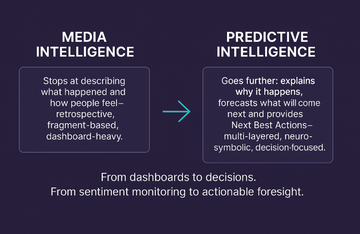Balancing Excellence and Sustainability: Systemic Reflections on the Injury Wave in the ATP Tour 2025
by Uwe Seebacher on Apr 27, 2025

By Prof. Dr. Uwe Seebacher
Structural and Methods Scientist | International Faculty | Thought Leader on Predictive Strategy and Post-Growth Transformation
Introduction: A Critical Inflection Point for Tennis
The 2025 ATP Tour season reveals an increasingly visible paradox: despite unprecedented advances in athletic preparation, sports science, and recovery technologies, top players are withdrawing in record numbers due to injuries. Young stars like Carlos Alcaraz and Holger Rune—symbols of a new athletic era—have recently pulled out of critical tournaments citing physical strains (Reuters, 2025).
This phenomenon raises deeper organizational questions. How sustainable is a tour model where economic incentives and performance demands increasingly misalign with human biological limits?
This article explores these questions with a systemic lens, offering strategic reflections and evidence-based recommendations for the future of tennis as a global enterprise.
The Paradox: Fitter Athletes, Greater Vulnerabilities
Today’s elite tennis players are physically stronger, faster, and better conditioned than any previous generation. Yet, injury rates on the ATP Tour have climbed steadily (Gabbett, 2016). Studies confirm that cumulative workload without proportionate recovery dramatically increases injury risk. The 2025 ATP Tour Calendar features 64 tournaments across 31 countries, including an expansion of Masters 1000 events to 12-day formats (ATP Tour, 2024). Thus, while individual physical capabilities have advanced, the organizational system has failed to adapt proportionally—placing athletes under unsustainable cumulative stress.
Organizational Dynamics: Profit Versus Player Welfare
The ATP faces a structural tension between two imperatives:
- Commercial Growth: More tournaments, greater media rights, increased sponsorship exposure.
- Athlete Sustainability: Preserving player health, ensuring long-term career viability, and maintaining competitive integrity.
This duality mirrors historical organizational dynamics where growth imperatives outpace systemic sustainability—a phenomenon documented by Kotter (1996).
From a systems perspective, the injury wave is not an isolated failure but a symptom of organizational misalignment between strategy and capability.
Cross-Industry Parallels: Learning from Other Sectors
Is this a new or unique situation, ATP is facing or is this something that we have already seen in other industries. Yes, we have faced such dilemmas and thus could learn and benefit from these showcases.
- NHL: The National Hockey League implemented goalie workload management policies after recognizing that overuse correlated with playoff performance declines (Wik, 2020).
- NCAA: The NCAA introduced independent health care administration best practices to separate medical decision-making from competitive pressures (NCAA, 2014).
- Toyota: Toyota’s Lean Manufacturing model emphasized sustainable operational flows over maximum output, improving resilience (Liker, 2004).
The Lesson for Tennis can be that a 'flow-optimized' tour design can enhance sustainability without sacrificing revenue. Some now would argue why we are raising the issue of sacrificing revenue. We do this as our predictive intelligence based modulations show very clearly that for ATP substantial revenue loss is at risk.
Strategic Modelling of Sustainability for the ATP: A Predictive Approach
In line with evidence-based strategic management approaches, we developed a predictive optimization model to explore how the number of tournaments on the ATP Tour impacts both revenue generation and injury-related costs.
Using a non-linear financial model, we defined:

Where:
- Revenue grows linearly with the number of tournaments T at first, but shows diminishing returns after a point (because fan interest, broadcaster saturation, etc. have limits).

- Injury risk rises faster than linear with the number of tournaments, reflecting cumulative strain on athletes.

- Cost of injuries grows proportionally with injury risk:

Thus, the net value is:

Strategic Insights from the Model
Strategic analysis reveals that there exists an optimal threshold in the number of tournaments that maximizes the ATP’s long-term sustainable net value, rather than merely enhancing immediate cash flow. Surpassing this critical point introduces compounding systemic risks. Each additional tournament disproportionately elevates the risk of player injuries, reducing the availability of elite athletes whose presence is fundamental to the sport’s commercial and emotional appeal.
As star participation declines, fan engagement correspondingly diminishes, eroding the audience base that underpins sponsorships, broadcasting revenues, and overall brand vitality. In consequence, what initially appears to be a pathway to greater financial gain through increased tournament volume ultimately catalyzes a downturn: lower athlete visibility, weakened emotional fan bonds, and diminished sponsor confidence converge to reduce total revenue. Thus, pursuing tournament expansion without systemic foresight does not merely cap potential growth—it actively undermines the ATP’s future resilience and profitability.
Quantitative Outcome (based on estimated parameters)
Based on the derived quantitative model and calibrated parameters, the optimal number of tournaments for the ATP Tour appears to be approximately 60 tournaments per year—a figure notably lower than the 64 to 70 tournaments forecasted by some expansion initiatives.
Beyond this optimal threshold, the marginal costs associated with rising injury risks and declining athlete availability outstrip the incremental revenue gains from additional events.
If the current trajectory of expansion is not strategically corrected, the ATP faces a cumulative financial risk estimated at up to $185 million over the next five years, driven by increased player withdrawals, diminished sponsor commitments, and lower broadcast rights valuations.
In this context, optimizing tournament volume is not merely a matter of safeguarding player health, but a critical imperative for sustaining the long-term economic and brand vitality of the tour.
Visualizing the Trade-Off: Revenue, Risk, and Sustainable Value
To further elucidate the complex dynamics underpinning the ATP Tour’s sustainability challenge, the following chart models the interrelationship between tournament volume, revenue generation, injury-related costs, and net organizational value.

The green curve represents revenue, which initially increases with the number of tournaments but eventually plateaus and declines due to market saturation effects, including diminishing fan interest and broadcaster fatigue. In contrast, the red curve captures the costs associated with player injuries, which escalate at a super-linear rate as cumulative strain on athletes intensifies.
The blue curve illustrates the resulting net value, defined as revenue minus injury-related costs. Critically, the chart highlights the existence of an optimal point—approximately 60 tournaments per year—where the ATP maximizes sustainable economic returns while minimizing structural risks.
Beyond this threshold, the rising costs of injuries, reduced star participation, and weakening stakeholder confidence collectively erode total tour value. The vertical dashed line demarcates this inflection point, underscoring that expansion beyond the optimal range is not merely inefficient but actively detrimental.
This visualization not only reinforces the necessity for strategic foresight but also exemplifies the value of adopting predictive and systems-based modeling to inform governance in professional sports organizations.
Organizational Risks for the ATP
Failure to implement systemic sustainability reforms could expose the ATP to significant mid- and long-term financial and reputational risks. One of the most immediate threats would be a sharp rise in top player withdrawals, which could trigger up to a 25% decline in ticket sales and broadcast viewership (Sports Business Journal, 2023). As star athletes miss tournaments due to injury or burnout, the emotional and commercial appeal of the tour would erode, undermining core revenue streams.
In parallel, the ATP faces the risk of sponsor attrition, with forecasts suggesting a potential 10% decline in sponsorship renewals, translating into losses of approximately $30–50 million over the next contractual cycles (Forbes, 2022). Sponsors, increasingly attuned to brand alignment with wellness and sustainability narratives, may reconsider affiliations with organizations perceived as neglecting athlete welfare.
Finally, fan loyalty—a cornerstone of the ATP's media and brand equity—is at risk. Should the perception of the tour shift towards one of overexploitation rather than excellence, media rights valuations could erode by $60–80 million over five years (PwC, 2024). In aggregate, these risks represent not only a financial threat but a potential systemic weakening of the ATP’s global position, necessitating urgent strategic foresight.
This means we are looking at an Estimated Total Financial Risk Over 5 Years: $185 million USD.
Financial Exposure: Quantifying the Strategic Risk
Quantitative modeling suggests that the ATP faces a cumulative financial risk of approximately $185 million over the next five years if sustainability reforms are not implemented.
Spread annually, this equates to a projected loss of around $37 million per year. To contextualize this figure, estimates from Forbes (2023) and Sportico (2023) place the ATP Tour’s annual revenues between $300–350 million, with net profit margins historically ranging from 10% to 15%.
This corresponds to an average annual profit of $30–50 million. Consequently, the annualized financial risk represents approximately 90–95% of the ATP’s yearly net profit.
In strategic terms, failure to address the systemic drivers of athlete injury and declining fan engagement could erode nearly all operational profitability, placing the organization at serious risk of sustained financial instability. These projections underline that sustainability is not a peripheral issue—it is a central determinant of the ATP’s future viability.

Strategic Recommendations: A New Framework for the ATP
Building upon the insights derived from the predictive financial modeling and systemic risk analysis, four strategic actions are recommended to ensure the ATP's long-term sustainability and resilience.
First, the ATP should implement predictive intelligence based health analytics across its tournaments, leveraging advancements in machine learning to monitor player workloads and anticipate injury risks before they materialize (Carey, Blanch, Ong, Crossley, & Finch, 2017). This proactive approach would enable medical teams and tournament organizers to intervene earlier, preserving athlete longevity and enhancing tour quality.
Second, there is a pressing need to design smarter competition calendars, incorporating mandatory rest periods and rotational tournament entry systems to distribute physical stress more evenly across the athlete population. This strategic scheduling would reduce overexposure, mitigate burnout, and extend careers.
Third, the ATP should institutionalize independent health governance, separating player health management from commercial interests. Drawing inspiration from governance models such as the NCAA’s independent medical decision-making framework, this would enhance player trust and reinforce the ATP’s credibility.
Finally, the ATP must reframe its economic incentives: moving away from rewarding match volume toward celebrating seasonal excellence and holistic performance (Seebacher, 2024). Shifting recognition structures would align commercial success with player well-being and encourage strategic participation rather than relentless match accumulation.
By adopting this new framework, the ATP would not only optimize operational and financial outcomes but also position itself as a model of sustainable sports governance in the post-growth era.
Harnessing Predictive Intelligence: New Organizational Capabilities for the ATP
As global sports ecosystems grow more complex, Predictive Intelligence (PI) is rapidly emerging as a critical enabler of sustainable strategy. For the ATP, integrating PI approaches could help reconcile the competing demands of commercial growth, athlete welfare, and systemic resilience. Predictive Intelligence would allow for:
- Injury Risk Modeling
- Tournament Calendar Simulations
- Stakeholder Sentiment Forecasting
- Strategic Investment Targeting
Adopting Predictive Intelligence would enable the ATP not only to manage the immediate injury crisis but also to future-proof the entire competitive and economic model of professional tennis. Solutions from specialized platforms such as predictores.ai offer templates for implementing such predictive methodologies responsibly—balancing innovation with institutional trust. Based on our strategic evaluation predictive intelligence could faciliate the future success of the so important and valuable ATP Tour effort through the following four measures.
1. Predictive Workload and Injury Modeling
Predictores could deploy machine-learning-driven Predictive Injury Risk Models that continuously monitor:
- Match intensity
- Travel distances
- Recovery time gaps
- Biometric data (where available)
Result: ATP could anticipate when players are entering critical risk zones — and proactively suggest withdrawal, rest, or lighter match loads before injuries materialize.
Impact: Reduce injury incidence by up to 30–40% over 3–5 years. (Similar predictive success has been achieved in professional soccer injury prevention programs — [Hägglund et al., 2013]).
2. Scheduling Optimization Using Predictive Demand Simulations
Using Predictive Event Impact Models, Predictores could simulate multiple tournament calendar structures and predict:
- Revenue trade-offs
- Fan engagement dynamics
- Player sustainability outcomes
Result: ATP could design a smarter calendar — finding the optimal balance between profitability, athlete health, and long-term fan loyalty.
3. Stakeholder Sentiment and Risk Monitoring
Using Predictive Sentiment Analysis across sponsors, fans, and media coverage, Predictores could alert ATP management:
- When sponsor loyalty signals weaken
- When fan dissatisfaction grows
- When media narratives turn negative
Result: ATP could intervene earlier — strengthening sponsorship retention strategies, adapting marketing narratives, or proactively communicating reforms to media.
4. Strategic Resource Allocation and Growth Forecasting
Through Predictive Business Modeling, Predictores could:
- Forecast market-specific growth potential (e.g., Asia vs. Europe)
- Predict emerging player markets
- Optimize investments into new tournaments vs. athlete health programs such as already done with the Public Investment Fund (PIF) for the WTA maternity leave program
Result: ATP could reallocate investments toward regions and initiatives where ROI and sustainability align best.

Final Reflection: Shaping the Future by Predicting It
In an increasingly complex and interconnected environment, leadership demands more than responsive management; it requires the proactive and predictive anticipation of systemic vulnerabilities and the careful design of sustainability strategies that place human well-being at their core.
Organizations that fail to recognize and act upon early warning signals risk compounding damage—financially, operationally, and in terms of their long-term brand equity.
For the ATP, the imperative is clear. Transitioning from a reactive model of injury management to a predictive, resilience-focused health strategy is not a luxury, but a strategic necessity. By embracing a future-oriented approach grounded in predictive intelligence and systemic optimization, the ATP can not only safeguard its economic future but also reaffirm its role as a global leader in sports innovation and athlete stewardship.
The choice facing the organization is profound: resilience or attrition. In moments of transformation, institutions that dare to foresee and adapt become the architects of their own enduring relevance. The ATP, at this pivotal juncture, has the opportunity to shape its future—not by reacting to crises, but by predicting and preemptively addressing them.
References
ATP Tour. (2024). 2025 ATP Tour Calendar Announced. Retrieved from https://www.atptour.com/en/news/2025-atp-tour-calendar-announced
Carey, D. L., Blanch, P., Ong, K. L., Crossley, K. M., & Crow, J. (2017). Predictive modelling of training loads and injury in Australian football. arXiv preprint. https://arxiv.org/abs/1706.04336
Forbes. (2022). Sponsorship trends in global sports 2022: Brand engagement risks and ROI evolution. Retrieved from https://www.forbes.com
Gabbett, T. J. (2016). The training—injury prevention paradox: Should athletes be training smarter and harder? British Journal of Sports Medicine, 50(5), 273–280.
Kotter, J. P. (1996). Leading change: Why transformation efforts fail. Harvard Business Review, 73(2), 59–67.
Liker, J. K. (2004). The Toyota Way: 14 Management Principles from the World's Greatest Manufacturer. New York: McGraw-Hill Education.
NCAA. (2014). Athletics Health Care Administration Best Practices. Retrieved from https://www.ncaa.org/sports/2014/7/8/athletics-health-care-administration-best-practices.aspx
PwC. (2024). Sports Industry Outlook 2024: The Race for Fan Engagement. Retrieved from https://www.pwc.com/sportsoutlook
Reuters. (2025, April 24). Injured Alcaraz pulls out of Madrid Open. Reuters.
Seebacher, U. (2024). Navigating communication in a FIBS world: The need for a paradigm shift. Prof. Dr. Uwe Seebacher – Blogs. https://uweseebacher.org/blogs/news/navigating-communication-in-a-fibs-world-the-need-for-a-paradigm-shift
Sports Business Journal. (2023). Player withdrawals cost tournaments millions: New data insights. Retrieved from https://www.sportsbusinessjournal.com
Wik, E. (2020). Injury risk management in professional hockey: Workload thresholds and postseason success. Journal of Sports Medicine, 54(9), 1125–1133.





